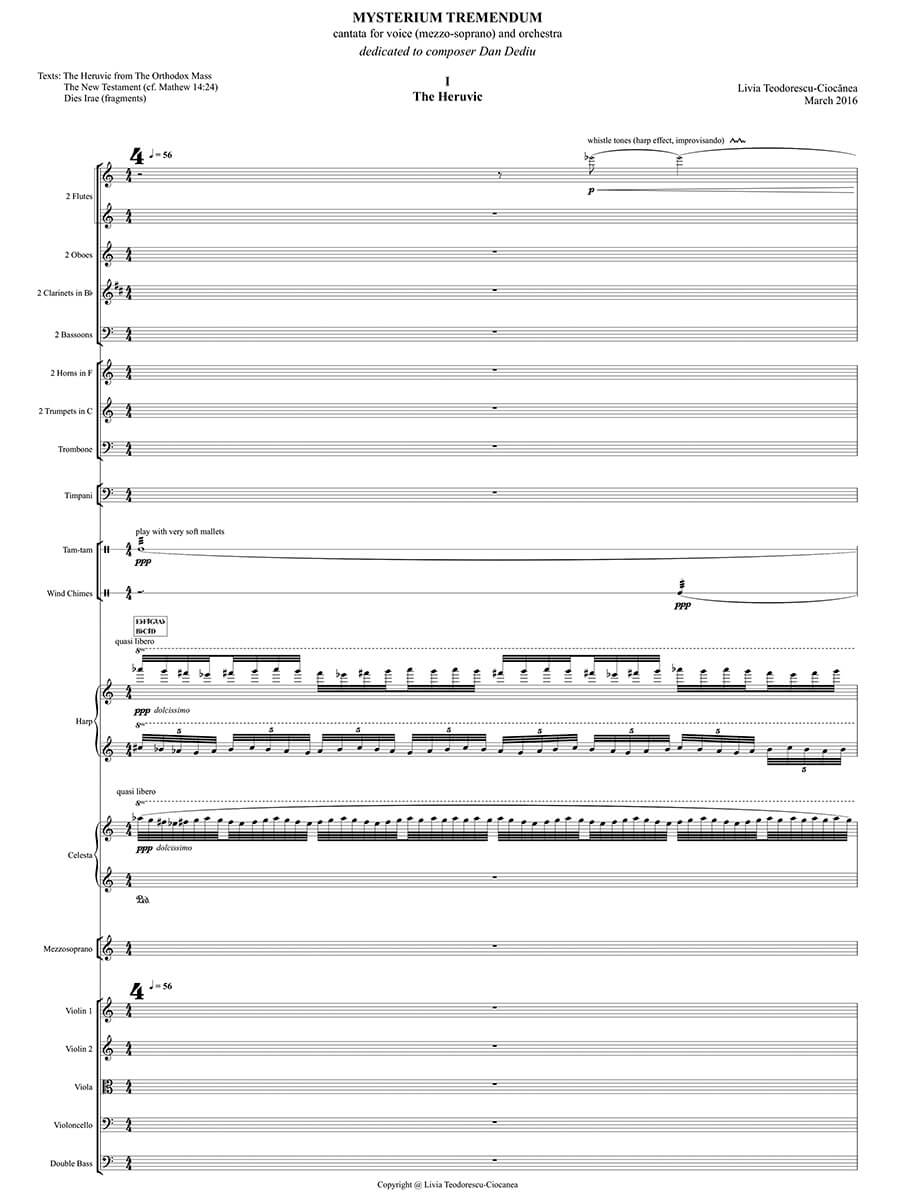Mysterium tremendum Cantata for mezzo-soprano (ossia Tenor) and orchestra (first print)
Teodorescu-Ciocănea, Livia
24,00 €
Preface
Teodorescu-Ciocănea, Livia – Mysterium tremendum Cantata for mezzo-soprano (ossia Tenor) and orchestra (first print)
Biography
Livia Teodorescu-Ciocănea was born in Galaţi, a town in eastern Romania, on 4 February 1959. She studied piano at the Music and Arts College in Galaţi between 1965 and 1977, where one of her piano teachers was Charlotte Marcovici, who had studied in Vienna in the 1940s. Teodorescu-Ciocănea entered the Ciprian Porumbescu Conservatoire (now the National University of Music) in Bucharest in 1977 and graduated in 1981 with a Bachelor’s degree in Composition. Her teachers there included Myriam Marbe for composition, Ştefan Niculescu for form and analysis, and Ioana Minei and Ana Pitiş for piano. In 1985 she also attended the piano master-classes given in the ‘Bartók Seminar’ in Szombathely, in Hungary, by Zoltán Kocsis and Imre Rohmann.
She turned to Ph.D. studies after the 1989 Romanian revolution, when the system changed and allowed more people to enrol in higher-degree work. She was admitted to a Ph.D. candidature in musicology at the National University of Music in Bucharest in 1996, studying with the composer Anatol Vieru and, later, with Octavian Nemescu. In 1998 and 1999 she obtained a Grant for Excellence from the Romanian government, which allowed her to transfer her Ph.D. studies to the University of Huddersfield in the UK for two consecutive years. There she undertook the composition part of her doctorate, studying with Margaret Lucy Wilkins. The result was a doctorate in both musicology and composition. In 1995 she was appointed assistant professor at the National University of Music in Bucharest, teaching form, analysis and orchestration. In 1997 she became a lecturer, and between 2004 and 2015 she worked as an Associate Professor in composition, form and analysis. In 2015 she became Professor of Composition at the same institution, and in 2017 she was appointed as an Adjunct Associate Professor (Research) at the Sir Zelman Cowen School of Music, Monash University in Melbourne. Since January 2021 she has been appointed Artistic Director of the Bucharest National Opera.
Teodorescu-Ciocănea has been a member of the Union of Composers and Musicologists in Romania since 1987, and her music has been performed in the USA, Australia, Hong Kong, Indonesia, Japan and across Europe and, of course, by leading orchestras in Romania, among them the George Enescu Philharmonic, National Radio and Chamber Radio Orchestras and the Orchestra of Bucharest National Opera. In 2008 she won an Australian Federal Government grant, the Endeavour Award Postdoctoral Research Fellowship, which was undertaken at Monash University.
Teodorescu-Ciocănea has been awarded a variety of prestigious prizes for her work as a composer, including that of the Union of Composers and Musicologists in Romania in 2001, 2003, 2006, 2009 and 2016. In 2008 she was awarded the ‘George Enescu’ Romanian Academy Award for Romulus and Remus (a trio for two violins and piano), and, in the same year, the National Order ‘Cultural Merit’ (Knight Grade) was bestowed upon her by the Romanian Presidency.
Teodorescu-Ciocănea’s has composed across the gamut of musical categories from opera, ballet, symphony, vocal- symphonic, concerti and choral through to smaller chamber, vocal and solo instrumental works. Her sources of inspiration include folklore and religious music, classical and theatrical forms, as well as multilayered spectralism.2 She follows in the footsteps of other Romanian composers, such as Horațiu Rădulescu and Ştefan Niculescu, who both explored the spectral approach to composition. Accordingly, she has written pieces with these characteristics for contemporary-music festivals; on the other hand, she has also written music with post-Romantic or post-Impressionist features. Her interest in timbre and spectralism is allied to a strong sense of structure. Indeed, she delineates form and structure through a technique she calls ‘hypertimbralism’, which achieves timbral drama by transforming interconnected instrumental layers of varying density: each layer can be brought to the foreground or sent to the background. This new poetic is to be found in its most obvious expression in her concertos: Déesses de l’Air (2012) for solo flute and flute orchestra (commissioned and played by Pierre Yves-Artaud and the Orchestre de Flûtes Français, premiered in Paris in 2012), Rite for Enchanting the Air (1999, premiered by Pierre-Yves Artaud with the University of Huddersfield Orchestra conducted by Barrie Webb in 2000 and in Romania in 2002 with the National Radio Orchestra conducted by Alan Tongue) and D’Amore (1997), an oboe concerto performed in 2000 by Eugen Glăvan with the George Enescu Philharmonic conducted by Cristian Mandeal.
More recent hyperspectral works include Mysterium tremendum (2016) for mezzo-soprano and orchestra and the String Quartet No. 2 Infloribus (2017). Drama and lyricism in a modern vision are found in her 2nd Piano Concerto called Lebenskraft (2008/rev. 2011) dedicated to Australian pianist Tamara Smolyar.
Read full preface (also Romanian version) > HERE
Score Data
| Special Edition | The Romanian Music Collection |
|---|---|
| Genre | Choir/Voice & Orchestra |
| Printing | First print |
| Pages | 78 |
| Special Size | 380 x 270 mm |
